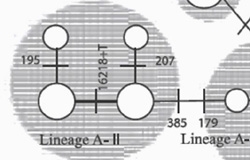The Taino Inside: Science Helps to Decipher Our Origins
Submitted by Greetchen Díaz-Muñoz on
Do you remember the stories about the native inhabitants of Puerto Rico that we were taught in school? Yes, the Taino Indians. They faded with the arrival of Spanish colonizers, according to the story. When exactly TaÌno ceased to exist? There is archaeological evidence indicating that the Tainos lived on the island longer than historians point, but there are still conflicting versions of both lines. Not only archaeologists and historians were interested in learning more about the Taino culture. A curious scientist that since he was a teenager was fascinated with stories about the Tainos, had in mind a number of questions, but mostly an effort to answer them.
Even earlier, at age 13, Dr. Juan C. Martínez Cruzado, a CienciaPR member, became interested in learning about the formation of life. Then, he decided to study biology at the University of Puerto Rico, Mayaguez Campus (UPRM). During that time he became interested specifically in DNA and its changes, and how these changes produce a particular phenotype. With little training in the area of molecular biology, Martínez Cruzado entered Harvard University to complete his doctorate in molecular evolution. The lack of training when he arrived at Harvard was a big challenge but also a great opportunity to learn and grow professionally. In his case, dedication prevailed. His doctoral thesis was published in the List of World Literature Bibliography of Current Opinion in Genetics and Development, in December 1991.
Dr. Martínez Cruzado returned to Puerto Rico as a professor at UPRM. He recalled that in addition to his curiosity about evolution, he was carrying stories about the Tainos learned on trips of the Association of Students of Biology, UPRM to Jayuya and to the indigenous parks of the island. With a sense of patriotism he felt the need to contribute. That opportunity came when he studied the DNA of indigenous bones, thanks to the interest of the former director of the Archaeology Program of the Institute of Puerto Rican Culture and a member of CienciaPR, Professor John J. Aguilú Ortiz. These early studies were inconclusive, but were the beginning of an interesting story.
Previously, it had been described the non-recombining mitochondrial DNA (mtDNA) which is inherited through the mother. In addition, mtDNA can be classified into haplogroups, which are specific for different regions. This peculiarity makes mtDNA an important tool to study the maternal lineage (the study of lineage through the mother and maternal ancestors).
Dr. Martínez Cruzado hypothesized that he might find indian mtDNA in Puerto Ricans with similar physical characteristics to the them. Martínez Cruzado was not wrong, but surprisinglyhe also found that the indian mtDNA was present in a high percentage of Puerto Ricans regardless of their physic. These findings prompted the National Science Foundation (NSF) to finance his project. Using a representative sample of the island, he found that 61% of Puerto Ricans has an Indian mtDNA origin. This proportion rises to 72% on all two-thirds of the island which lies to the west of the Rio La Plata, but, interestingly, did not reveal a higher percentage at the center of the island. Among Puerto Ricans, mtDNA of European and African origin had more variability, while the indian mtDNA is more homogeneous in the studied populations. The biggest contribution, according to Martinez Cruzado, was to determine that it was possible to study the native maternal lineage in the Puerto Ricans. In historical terms, their findings were also important to describe a South American link to the natives of P.R. A subsequent study conducted in collaboration with the laboratory of Esteban González Burchard of the University of California at San Francisco, on autosomal DNA showed that indian heritage is distributed evenly throughout the island with little variation from individual to individual. Beyond determining whether the Taino indians disappeared within a particular time, these results imply that the mixing occurred among Puerto Ricans long time ago.
There is still more to learn. We have found that we can study the indigenous lineage using the mestizo population in South American regions. Dr. MartÌnez Cruzado collaborates
with other colleagues to expand the knowledge of our indigenous ancestry using autosomal DNA, mitochondrial and Y chromosome. His story is an example of how science can serve humanity, in this case serving to history and our origins. To find out more about Dr. Martínez Cruzado, visit his profile at CienciaPR.org. You can also see an interesting visual on this topic.








